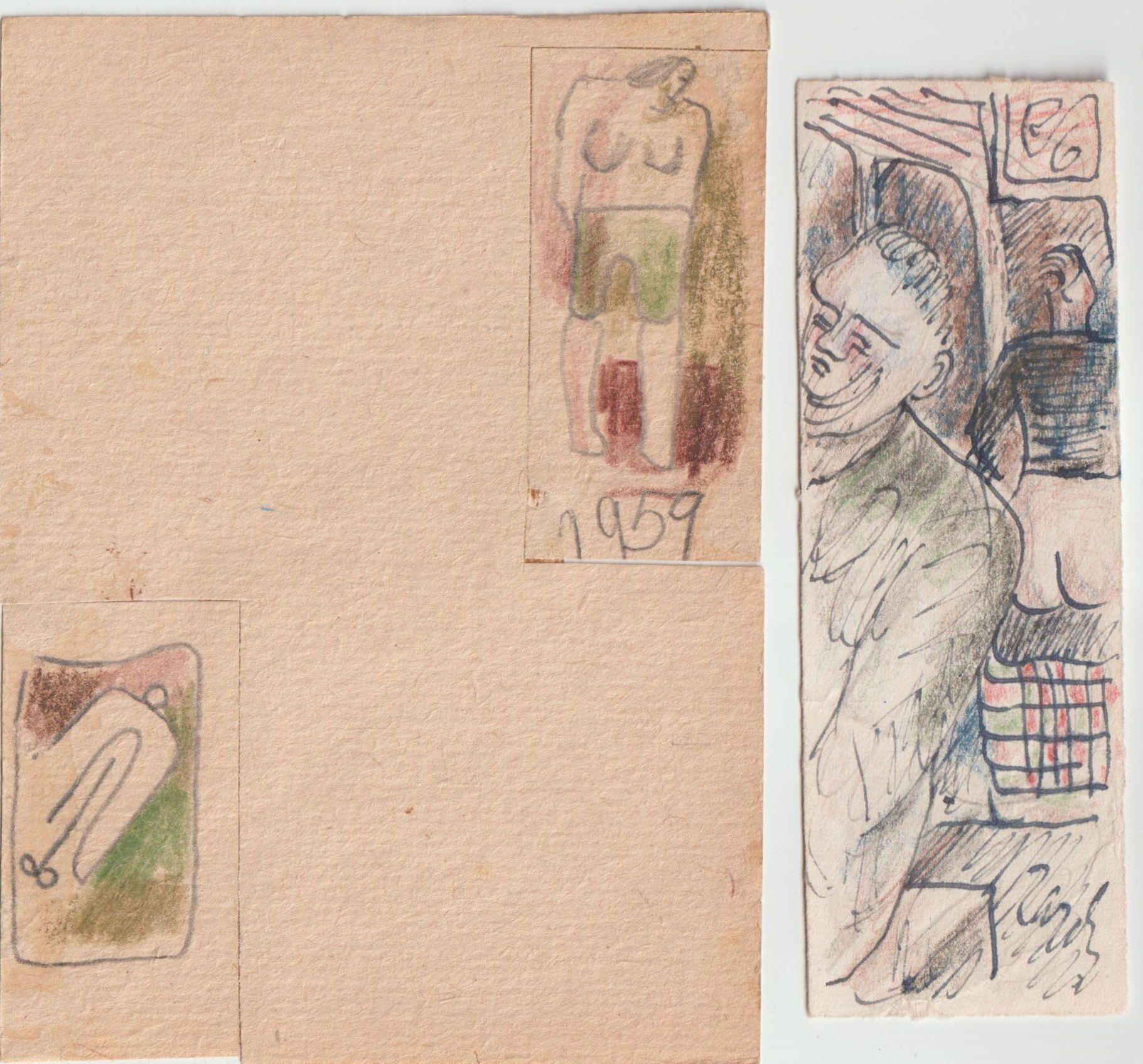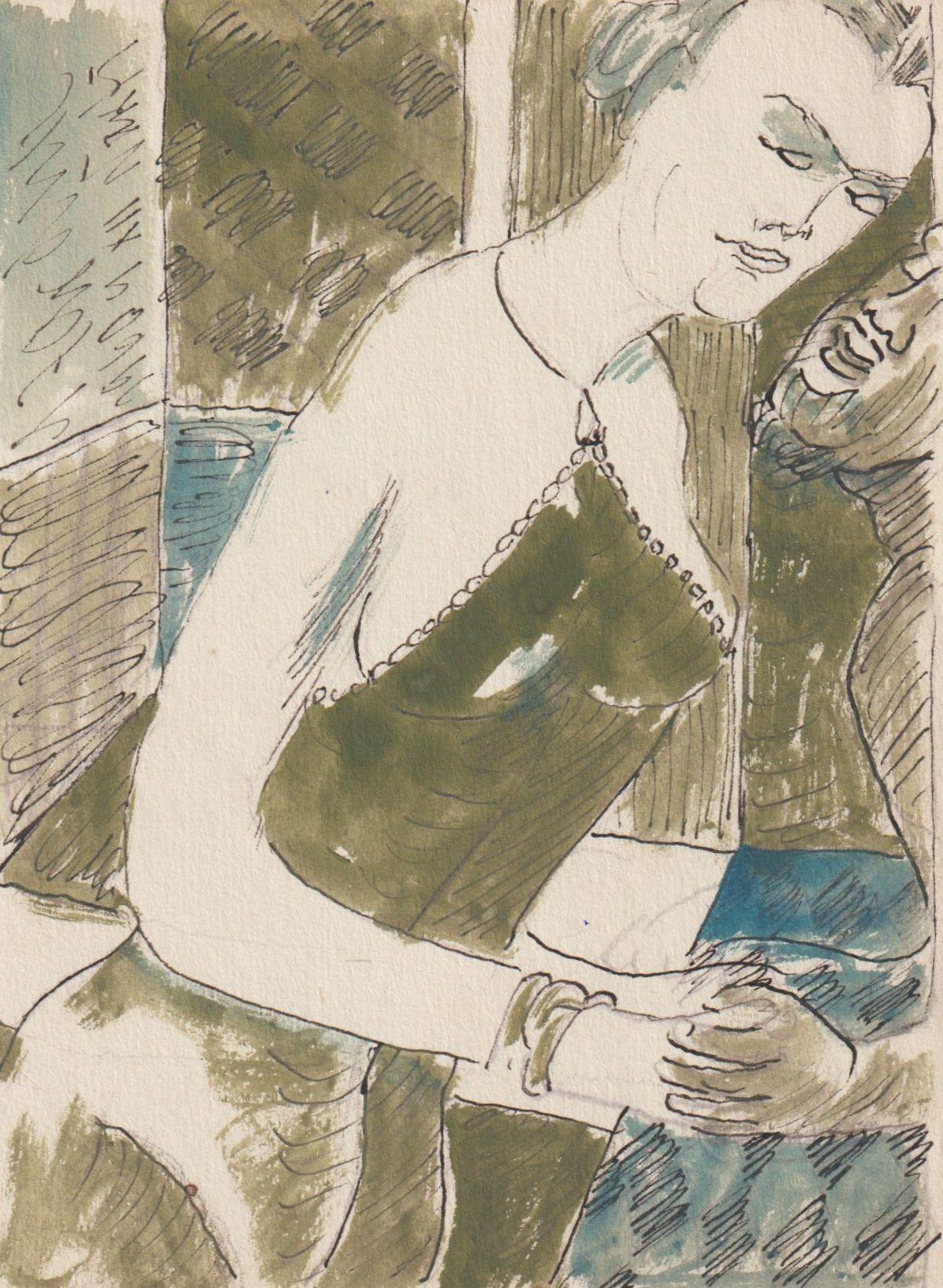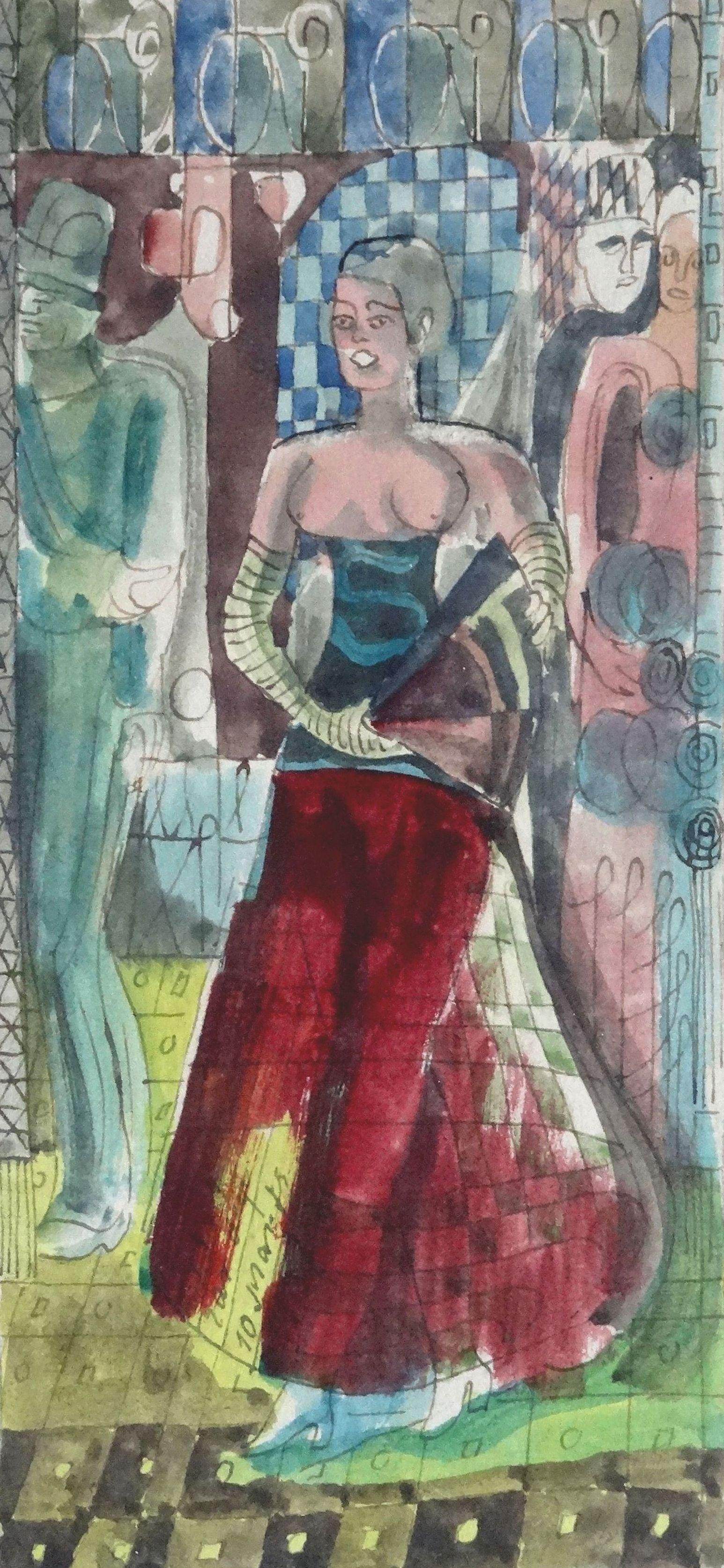Items Similar to Circus Jumpers #2 (Equestrians) mixed media painting by Jon Corbino
Want more images or videos?
Request additional images or videos from the seller
1 of 10
Jon CorbinoCircus Jumpers #2 (Equestrians) mixed media painting by Jon CorbinoCirca 1950
Circa 1950
About the Item
Signed "Corbino" lower left
Inscribed on frame by artist with artist's address in Rockport, MA
Titled by artist on inscription verso.
Provenance: Oelschlaeger Gallery, Chicago, IL. (label verso)
From the artist's July 11, 1964 NYT obituary:
Jon Corbino, painter, whose canvases are represented in 35 museums and galleries, died yesterday at the age of 59.
Mr. Corbino's work, freely described as romantic realism, was characterized by technical skill, vivid color, and scenes of action and movement. Thematically and technically, he was influenced in his early days by the works of DeIacroix and 17century Spanish painters.
He flourished in the nineteenthirties and forties when his dramatic canvases responded to the intellectual climate of those decades. His paintings continued to find many purchasers in the Middle West and Florida until his death.
Commenting on an exhibition of Mr. Corbino's works in 1959, one critic said:
“Romanticism bounds back in Jon Corbino's high spirited circus paintings. Horses and riders, acrobats and dancers perform the liveliest feats in these pictures.
“As compositions they are rather untidily put together, but they show real strength in the representation of movement. Color is, as always with Corbino, warm, pretty, and extremely sweet”
Mr. Corbino was born in Vittorio, Italy, April 3, 1905. At the age of 8 he was brought to the United States, where he attended the Ethical Culture School and the Art Students League here and the Pennsylvania Academy of Fine Arts. He was awarded Guggenheim Fellowships in 1936 and 1937.
Mr. Corbino's forceful, dramatic style won him early recognition and popularity, and oneman shows of his art were given with increased frequency. He received numerous prizes, awards, and medals. Among the museums and galleries that possess Corbino works are the Metropolitan Museum of Art, the Chicago Art Institute, the Whitney Museum, the Brooklyn Museum, the Carnegie Institute and the Brooks Memorial Art Museum in Memphis.
Mr. Corbino is survived by his widow, the former Marcia Norcross, and six children.
- Creator:Jon Corbino (1905 - 1964, American)
- Creation Year:Circa 1950
- Dimensions:Height: 18.5 in (46.99 cm)Width: 24 in (60.96 cm)
- Medium:
- Movement & Style:
- Period:
- Condition:
- Gallery Location:Hudson, NY
- Reference Number:
About the Seller
5.0
Vetted Seller
These experienced sellers undergo a comprehensive evaluation by our team of in-house experts.
Established in 1973
1stDibs seller since 2023
5 sales on 1stDibs
Typical response time: <1 hour
- ShippingRetrieving quote...Ships From: Hudson, NY
- Return PolicyThis item cannot be returned.
More From This SellerView All
- Homage to the Spanish Republic by Julio De DiegoBy Julio de DiegoLocated in Hudson, NYAn early work by Julio De Diego embodies the love he had for his homeland of Spain, as well as strong emotions against war. The peacefulness of the couple holding hands looking down ...Category
1930s Modern Paintings
MaterialsMasonite, Oil
- Ceremonial Dancers oil and tempera painting by Julio De DiegoBy Julio de DiegoLocated in Hudson, NYArtwork measures 48" x 30" and framed 56 ¼" x 38 ¼" x 3" Provenance: John Heller Gallery, NYC, circa 1975 (label verso) The artist's daughter Corbino Galleries, Sarasota, FL (1990)...Category
1940s Modern Abstract Paintings
MaterialsMasonite, Oil, Tempera
- The Magician oil and tempera painting by Julio de DiegoBy Julio de DiegoLocated in Hudson, NYJulio De Diego’s Atomic Series paintings made an extraordinary statement regarding the shock and fear that accompanied the dawn of the nuclear age. In the artist’s own words, “Scientists were working secretly to develop formidable powers taken from the mysterious depths of the earth - with the power to make the earth useless! Then, the EXPLOSION! . . . we entered the Atomic Age, and from there the neo-Atomic war begins. Explosions fell everywhere and man kept on fighting, discovering he could fight without flesh.” To execute these works, De Diego developed a technique of using tempera underpainting before applying layer upon layer of pigmented oil glazes. The result is paintings with surfaces which were described as “bonelike” in quality. The forms seem to float freely, creating a three-dimensional visual effect. In the 1954 book The Modern Renaissance in American Art, author Ralph Pearson summarizes the series as “a fantastic interpretation of a weighty theme. Perhaps it is well to let fantasy and irony appear to lighten the devastating impact. By inverse action, they may in fact increase its weight.” Exhibited 1964 Marion Koogler McNay Art Institute, San Antonio, Texas This work retains its original frame which measures 54" x 42" x 2" About this artist: Julio De Diego crafted a formidable persona within the artistic developments and political struggles of his time. The artist characterized his own work as “lyrical,” explaining, “through the years, the surrealists, the social-conscious painters and the others tried to adopt me, but I went my own way, good, bad or indifferent.” [1] His independence manifested early in life when de Diego left his parent’s home in Madrid, Spain, in adolescence following his father’s attempts to curtail his artistic aspirations. At the age of fifteen he held his first exhibition, set up within a gambling casino. He managed to acquire an apprenticeship in a studio producing scenery for Madrid’s operas, but moved from behind the curtains to the stage, trying his hand at acting and performing as an extra in the Ballet Russes’ Petrouchka with Nijinsky. He spent several years in the Spanish army, including a six-month stretch in the Rif War of 1920 in Northern Africa. His artistic career pushed ahead as he set off for Paris and became familiar with modernism’s forays into abstraction, surrealism, and cubism. The artist arrived in the U.S. in 1924 and settled in Chicago two years later. He established himself with a commission for the decoration of two chapels in St. Gregory’s Church. He also worked in fashion illustration, designed magazine covers and developed a popular laundry bag for the Hotel Sherman. De Diego began exhibiting through the Art Institute of Chicago in 1929, and participated in the annual Chicago Artists Exhibitions, Annual American Exhibitions, and International Water Color Exhibitions. He held a solo exhibition at the Art Institute of Chicago in the summer of 1935. Though the artist’s career was advancing, his family life had deteriorated. In 1932 his first marriage dissolved, and the couple’s young daughter Kiriki was sent to live with friend Paul Hoffman. De Diego continued to develop his artistic vocabulary with a growing interest in Mexican art. He traveled throughout the country acquainting himself with the works of muralists such as Carlos Merida, and also began a collection of small native artifacts...Category
1940s American Modern Abstract Paintings
MaterialsMasonite, Oil, Tempera
- Fish Story oil painting by Williams Charles PalmerLocated in Hudson, NYThis painting is illustrated in the Catalogue of the 1945 Encyclopedia Britannica Collection of Contemporary American Painting, p.84. Written and edited by Grace Pagano. "Painting ...Category
Mid-20th Century American Modern Figurative Paintings
MaterialsOil, Canvas
- St. Atomic oil and tempera painting by Julio de DiegoBy Julio de DiegoLocated in Hudson, NYJulio De Diego’s Atomic Series paintings made an extraordinary statement regarding the shock and fear that accompanied the dawn of the nuclear age. In the artist’s own words, “Scientists were working secretly to develop formidable powers taken from the mysterious depths of the earth - with the power to make the earth useless! Then, the EXPLOSION! . . . we entered the Atomic Age, and from there the neo-Atomic war begins. Explosions fell everywhere and man kept on fighting, discovering he could fight without flesh.” To execute these works, De Diego developed a technique of using tempera underpainting before applying layer upon layer of pigmented oil glazes. The result is paintings with surfaces which were described as “bonelike” in quality. The forms seem to float freely, creating a three-dimensional visual effect. In the 1954 book The Modern Renaissance in American Art, author Ralph Pearson summarizes the series as “a fantastic interpretation of a weighty theme. Perhaps it is well to let fantasy and irony appear to lighten the devastating impact. By inverse action, they may in fact increase its weight.” Exhibited 1950 University of Illinois at Urbana "Contemporary American Painting" 1964 Marion Koogler McNay Art Institute, San Antonio, Texas This work retains its original frame which measures 54" x 36" x 2". About this artist: Julio De Diego crafted a formidable persona within the artistic developments and political struggles of his time. The artist characterized his own work as “lyrical,” explaining, “through the years, the surrealists, the social-conscious painters and the others tried to adopt me, but I went my own way, good, bad or indifferent.” [1] His independence manifested early in life when de Diego left his parent’s home in Madrid, Spain, in adolescence following his father’s attempts to curtail his artistic aspirations. At the age of fifteen he held his first exhibition, set up within a gambling casino. He managed to acquire an apprenticeship in a studio producing scenery for Madrid’s operas, but moved from behind the curtains to the stage, trying his hand at acting and performing as an extra in the Ballet Russes’ Petrouchka with Nijinsky. He spent several years in the Spanish army, including a six-month stretch in the Rif War of 1920 in Northern Africa. His artistic career pushed ahead as he set off for Paris and became familiar with modernism’s forays into abstraction, surrealism, and cubism. The artist arrived in the U.S. in 1924 and settled in Chicago two years later. He established himself with a commission for the decoration of two chapels in St. Gregory’s Church. He also worked in fashion illustration, designed magazine covers and developed a popular laundry bag for the Hotel Sherman. De Diego began exhibiting through the Art Institute of Chicago in 1929, and participated in the annual Chicago Artists Exhibitions, Annual American Exhibitions, and International Water Color Exhibitions. He held a solo exhibition at the Art Institute of Chicago in the summer of 1935. Though the artist’s career was advancing, his family life had deteriorated. In 1932 his first marriage dissolved, and the couple’s young daughter Kiriki was sent to live with friend Paul Hoffman. De Diego continued to develop his artistic vocabulary with a growing interest in Mexican art. He traveled throughout the country acquainting himself with the works of muralists such as Carlos Merida, and also began a collection of small native artifacts...Category
1940s American Modern Abstract Paintings
MaterialsMasonite, Oil, Tempera
- The Lonely Road by William Charles PalmerLocated in Hudson, NYThe Lonely Road (1940) Tempera on panel 12" x 16" 19 1/2" x 23 1/2" x 1 1/2" framed Hand-signed "Palmer '40" lower center. Provenance: Midtown Galleries, New York, NY (labels verso...Category
Mid-20th Century American Modern Figurative Paintings
MaterialsPanel, Tempera
You May Also Like
- Erotic motives. 3.pcs., paper, mixed media, 12, 6x4, 3 cm, 6, 1x3, 2 cm, 6, 9x3, 2 cmLocated in Riga, LVErotic motives. 3.pcs., paper, mixed media, 12,6x4,3 cm, 6,1x3,2 cm, 6,9x3,2 cm small three drawings with erotic motives Adolfs Zardins (1890 08 II Riga...Category
Late 20th Century Modern Figurative Paintings
MaterialsPaper, Watercolor, Mixed Media
- Archaic dancer. 1933, paper, mixed media, 20x9.5 cmLocated in Riga, LVArchaic dancer. 1933, paper, mixed media, 20x9.5 cm Adolfs Zardins (1890 08 II Riga, Latvia – 1967 07 II Jurmala, Latvia), painter. Only in 1990 his rel...Category
1930s Modern Figurative Paintings
MaterialsPaper, Ink, Mixed Media, Watercolor
- Kiss at night. Paper, mixed media, 14x10, 3 cmLocated in Riga, LVKiss at night. Paper, mixed media, 14x10,3 cm Adolfs Zardins (1890 08 II Riga, Latvia – 1967 07 II Jurmala, Latvia), painter. Only in 1990 his relatives...Category
Late 20th Century Modern Figurative Paintings
MaterialsPaper, Mixed Media, Watercolor
- Mirror. Paper, mixed media, 10x14 cmLocated in Riga, LVMirror. Paper, mixed media, 10x14 cm Adolfs Zardins (1890 08 II Riga, Latvia – 1967 07 II Jurmala, Latvia), painter. Only in 1990 his relatives give his artistic heritage to publici...Category
Late 20th Century Modern Figurative Paintings
MaterialsPaper, Mixed Media, Watercolor
- Four women with puppets. 1947, paper, mixed media, 16.3x11 cmLocated in Riga, LVFour women with puppets. 1947, paper, mixed media, 16.3x11 cm Adolfs Zardins (1890 08 II Riga, Latvia – 1967 07 II Jurmala, Latvia), painter. Only in 1990 his relatives give his art...Category
1940s Modern Figurative Paintings
MaterialsPaper, Ink, Mixed Media, Watercolor
- At night. 1961. Paper, mixed media, 14x10 cmLocated in Riga, LVAt night. 1961. Paper, mixed media, 14x10 cm Adolfs Zardins (1890 08 II Riga, Latvia – 1967 07 II Jurmala, Latvia), painter. Only in 1990 his relatives give his artistic heritage to...Category
1960s Modern Portrait Paintings
MaterialsPaper, Ink, Mixed Media, Watercolor




